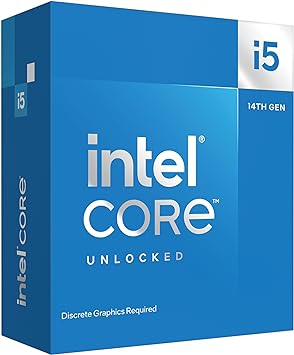Intel Core i5-14600KF

The Intel Core i5-14600KF is a powerful 14-core CPU designed for high performance, featuring a base clock speed of 3.5 GHz and a maximum boost clock of 5.3 GHz. It supports up to 192 GB of memory with speeds of DDR5 5600 MT/s and is built on the 1700 socket architecture.
Popularity: Low
Performance:
Specifications:
Model: Intel Core i5-14600KF
Series: Intel® Core™ i5 Processors (14th gen)
Architecture: Products formerly Raptor Lake
Socket: 1700
Cores: 14
Threads: 20
Base Clock: 3.5 GHz
Max. Boost Clock: 5.3 GHz
L2 Cache: 20 MB
L3 Cache: 24 MB Intel® Smart Cache
TDP: 125 W
Power Consumption: 181.0 W
Max Memory: 192 GB
Max Memory Speed: Up to DDR5 5600 MT/s, Up to DDR4 3200 MT/s
Max Temp: 100 °C
PCI Express Version: 5.0 and 4.0
PCIe Lanes: 20
Overclocking:
Integrated GPU: No
Cooler Boxed: no
Instruction Set: 64-bit
Launch Date: Q4'23
Manufacturer Page: Link
Review
The Intel Core i5-14600KF represents a significant entry in the world of PC hardware, especially for those eyeing a balanced blend of performance and cost. With its architecture falling under Intel's Raptor Lake family, this processor offers 14 cores and 20 threads, clocking base speeds of 3.5 GHz and reaching boost levels up to 5.3 GHz.
Technical Specifications and Features
- Cores and Threads: 14 cores, 20 threads
- Clock Speed: Base 3.5 GHz, Boost 5.3 GHz
- Socket: FCLGA1700
- Max Memory: 192 GB
- Default TDP: 125 W, with a power peak at 181 W under load
- Cache: 20 MB L2, 24 MB L3 Intel® Smart Cache
- Memory Speed: Supports DDR5 up to 5600 MT/s
These specifications make it evident that the Intel Core i5-14600KF is built for high performance, showcasing enhanced multi-core processing abilities, ideal for multitasking and high-demand applications.
Performance Assessment
The Intel Core i5-14600KF truly shines in the realm of practical performance, especially when pitted against its main rivals such as the AMD Ryzen 5 7600X and even its predecessor the Intel Core i5-13600K. Benchmark tests show a commendable superiority in single-core performance, which significantly enhances gaming capabilities and single-threaded task efficiency (TechRadar).
This processor outperforms the Ryzen 5 7600X by 44% in average multi-core benchmarks, making it an attractive option for those requiring robust parallel processing power. Moreover, historical comparisons reveal a gated performance lead with the i5-14600KF outrunning its predecessor by a marginal 2.4% under creative workloads (TechRadar).
Thermal and Power Dynamics
However, the increase in performance does come with a trade-off. The i5-14600KF's power consumption is noted to peak at 101°C. Such thermal reaches necessitate robust cooling solutions to prevent potential throttling, as demonstrated in test setups using high-end AIO coolers like the MSI MAG Coreliquid E360 AIO (TechRadar). Additionally, a TDP of 125 W requires suitable management to maintain optimal operation.
Gaming and Creative Workflows
The processor's gaming strength emerges clearly with stable 60fps performance in 4K ultra settings, proving its merit in both current and past high-spec titles. A testament to its stability and ability to maintain low temperatures under such loads comes from user experiences with the Be Quiet! Dark Rock 4 cooler and supporting gear (LDLC Reviews).
Value Proposition and Conclusion
Priced competitively at $215.99, the Intel Core i5-14600KF offers a well-rounded package for mainstream users who prioritize both price and performance. While its advantages could be eclipsed by discounts on older models, it defines itself within a narrow market segment tailored for prebuilds and those who demand reliable mainstream performance without venturing into extreme territory (TechPowerUp).
In sum, the Intel Core i5-14600KF makes a persuasive case for itself as a component in contemporary setups, striking a balance between affordability and robust performance. However, like all hardware decisions, its fit is best evaluated against specific user requirements and future-proofing plans.